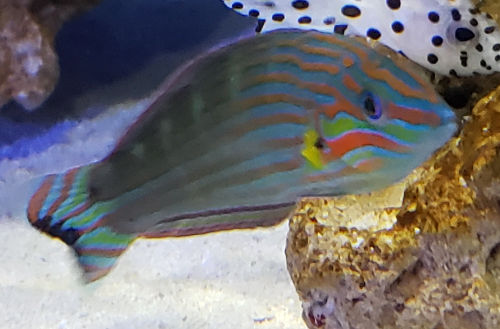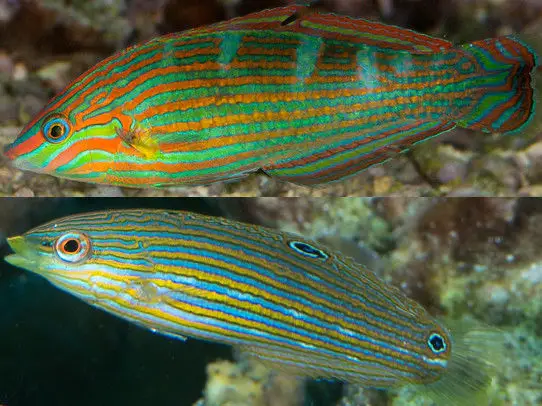
| Scientific Name | Halichoeres melanurus |
| Difficulty | Easy |
| Minimum Tank Size | 125 Gallons |
| Diet | Carnivore |
| Water Parameters | 72-78 F, pH 8-8.4, Salinity 1.020-1.025 |
| Aggression | Peaceful |
| Size | 6" |
The Melanurus Wrasse is one of the more peaceful wrasse that is commonly available. They have a similar coloration to the four and six line wrasse but are far less aggressive towards other fish in the tank. They will burrow in sand occasionally, meaning the Melanurus Wrasse should not be kept in bare bottom tanks.
When very hungry they do eat plenty of enjoyable saltwater inverts, like crabs, feather dusters, shrimp and snails. This makes them not suitable for tanks who use small inverts as a clean up crew. Even large Coral Banded Shrimp can be at danger, as the Melanurus Wrasse can get as big as six inches and has quite a big mouth. Keeping them well fed will greatly reduce the risk inverts will be at, but there is always a chance the Melanurus Wrasse will take a bite at your inverts. All these warnings aside they are able to be kept with inverts if you feed them four of five times a day.
Wrasse are extremely enjoyable additions to the tank, as they are always on the move. The Melanurus Wrasse will almost always be inspecting something. They will look at rocks, sand, fish, people, inverts, corals, equipment, power cords and just about anything in the tank.
Is The Melanurus Wrasse Reef Safe?
The Melanurus Wrasse is mostly reef safe, but they will eat many of the tanks small beneficial critters If they get too hungry. This means the Melanurus Wrasse is well suited to tanks with corals . For those looking to keep corals safe and parasite free, these wrasse are a great, non-aggressive answer.
For aquarists who are able to provide the Melanurus Wrasse with three of four meals a day inverts will be mostly safe. I would have no hesitation about putting a Melanurus Wrasse with any of my inverts. An automatic feeder or alarm for feeding will keep the wrasse well fed and your inverts safe.
The main reason the Melanurus Wrasse is seen as not reef safe or with caution is due to their feeding habits. Most aquarists will want to feed their fish only once or twice a day. For a wrasse this is simply not often enough, leaving them hunting in the tank and expanding their ideas of food.
Feeding the Melanurus Wrasse
So why does the Melanurus Wrasse require four meals per day when other fish are happy with just two? Unlike most fish, which swim around leisurely, wrasse will circle the tank nonstop. In fact that is probably why most aquarists try to pick one up. Their nonstop swimming results in a very small and short digestive system. They can only eat small amounts, and will need to eat again much sooner than their tank mates.
The diet of a Melanurus Wrasse should include:
- Frozen Mysis shrimp
- Brine Shrimp
- Prepared pellet food
- Occasional, once a week offering of seaweed/nori
One of the big upsides to the Melanurus Wrasse is their acceptance of prepared foods. They will almost always take pellets without hesitation, making them very easy to acclimate to any tank. The ease of food acceptance also makes varying their diet much easier than other fish, making the Melanurus Wrasse quite hardy once they are accustomed to their tank.
As for seaweed, also called nori, you only need to offer it a few times. If they never show an interest then just stop trying to feed it to them. It varies by wrasse if they want it or not. If you are buying a Melanurus Wrasse in store rather than ordering you can ask if they will accept nori before purchasing. The more varied their diet the better. Still, it is not the end of the world if they won’t accept nori.
Melanurus Wrasse Tank Requirements
First and foremost we need to remember that wrasse are not used to being close to the surface of the ocean. They will dart around the tank all the time, not remembering they can only swim a foot or three up before hitting the surface of the water. What this means is they will jump on accident quite frequently. They do not even need to be scared to do so. For this reason all wrasse should be kept in a closed tank with holes smaller than their heads.
Depending on the size your wrasse starts in, keeping all holes sealed well could be an easy or difficult task. The main thing aquarists forget is the cutouts around their powerheads wires and filtration tubes. These sections of the tank must be covered. An easy way to go about this is tying some filtration pads around them. Never use tape, as the humidity created by evaporating water will weaken the bonds it creates.
Now for a specific Melanurus Wrasse tank requirement. The Melanurus Wrasse belongs to the Halichoeres family, one compromised of over 75 wrasse. Each of these wrasse will burrow themselves under the sand, either when frightened or to sleep for the night. This means the Melanurus Wrasse must be kept with at least an inch of sand, if not more. Additionally, the sand in the tank must not be rough like crushed coral. 4mm and under is more acceptable.
When kept with gravel or coarse sand the Melanurus Wrasse will still try to burrow, harming itself in the process. These abrasions make the Melanurus Wrasse much more prone to illness and cause them undue stress. If kept with rough sands you can expect your wrasse to get sick and likely die not long after they enter the tank. After all, when first added to the tank they will be scared and are likely to hide in the sand.
Melanurus Wrasse Tank mates
While wrasse can seem aggressive in our eyes, they are surprisingly meek fish and cannot tolerate being with aggressive fish. Even some semi-aggressive tank mates will give the Melanurus Wrasse issues. Eels that do not eat fish are fine, but fish who chase nearby fish are a disaster. The Melanurus Wrasse’s behavior will lead them to swim by other fish constantly, which can provoke aggressive fish into chasing them. Even if they are not caught, chasing the wrasse around is not good for either fish.
Melanurus Wrasse tank mates should be fish around the same size, already comfortable with one another and little to no chasing existing between them.
One last note about Melanurus Wrasse tank mates is that they are open to other types of wrasse being in the same tank. Unlike some of the more aggressive wrasse, the Melanurus Wrasse will not harass other wrasse when given a tank with enough space for both. Even two males of different genus can be kept in the same tank when tensions are kept low enough.
It is important to note that the older fish get the less accepting they will become of each other. This is especially true for two males of similar species. This means you could have two wrasse in the same tank for 5 years without issue, only to see fighting occur much later in their lives.
The Melanurus Wrasse should not be kept with fish who depend on copepods. While they will accept just about any food, they will still hunt copepods in their free time. This makes keeping fish like dragonets impossible, as two pod eating fish will destroy even a 300 gallon tanks copepod population.
Acclimating the Melanurus Wrasse
Acclimation is especially important when it comes to wrasse. While they are quite hardy, they are nearly impossible to catch without dissembling the tank. Adding them to a tank only to have to remove every single rock to net them out is a huge hassle to the owner and will cause a huge amount of stress to your existing fish. Additionally this will kick up debris hidden under the sand, causing a rapid change in the waters pollution levels. In short by skipping acclimation you put your entire tank at risk, even if the added fish has no sickness what so ever.
To acclimate the Melanurus Wrasse you should first quarantine them in a smaller tank, a hospital or quarantine tank of 10-20 gallons will do, to watch for any odd behavior and sickness. This will also allow you to feed the fish on their own.
The Melanurus Wrasse quarantine tank should have a sand bed of at least one inch in depth, either across the entire tank or in a small sand box. It should also have the general quarantine tank items, which are a small powerhead, hang on back filter, screen cover and light. This keeps the tank aerated, secure from escapes, filtered while remaining inexpensive to set up and run. You can supplement the filter with filter media from their destination tank to add biological filtration that does not exist in the hospital tank.
Once you have determined the Melanurus Wrasse is safe to add to the tank you should then move them into an acclimation box inside of the tank. This allows them to get used to the tanks water and be safe while the existing tank mates come to look at them. During this time any aggressive fish, especially other wrasse, will either accept the new fish or show consistent signs of aggression to the wrasse.
If the existing fish show aggression for longer than five days you may need to return the wrasse or create a different tank to keep them. This is very unlikely but can happen.
Breeding & Gender
The Melanurus Wrasse has been bred in captivity, but not too successfully. You should not expect to breed them in your own home aquarium. While the Melanurus Wrasse has been seen spawning in tanks, the survival rate has been under 1% even in breeding studies. You can read more about this at the Rising Tide Conservation website.
The Melanurus Wrasse will start its life as a female, changing to a male if the situation allows it. This means they will likely become males if there are:
- No other male wrasse
- No aggressive fish keeping them in hiding
- Enough food for them to live comfortably
Male Melanurus Wrasse are often favored by aquarists as they will have a much brighter and more distinct coloration. With how colorful their body is strong colors are easily noticeable.

To ensure your Melanurus Wrasse becomes a male, therefore getting the stronger coloration, you should add them before any fish that will inhibit the change into a male. As they are not aggressive themselves this should pose no threat to other fish.
Even when added last or when kept with other males, most wrasse kept in captivity will eventually change into male. I just suggest the previous actions to make the change sooner.